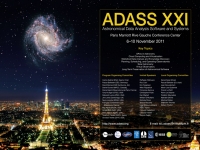Francois Viallefond (LERMA/OBSPM)
Abstract
With the evolution of the instrumentation the importance of data management is becoming more and more important. It is in direct relation with the continuously growing volume of data generated by the radio-telescopes pushing to more and more automated data processing.
For more than a decade the radio-astronomers have measured the importance of having a data model. A significant step was achieved $\sim$15 years ago with the definition of their ``Measurement Set'' (MS) which gives a static view of measurements put in context.
Although the content of their MS is closely related to their measurement equation, this later has a mathematical foundation which is not the case neither for the MS nor for by-products such as the ASDM, the model currently used by ALMA and the EVLA.
In this paper I will present an overview of important points in the elaboration of the theory of a fairly generic ``measurement set''. I will show that there is a continuity along a sequence of concepts, the numbers, quantities, physical quantities, physical measures and measurement sets. On one hand there is the definition of terms with their meanings and on the other the definition for structures, logical and algebraic. I will show that expressing the static view of
any physical quantity requires the definition of a topology. This topology must have an algebra to minimize the number of inductions. Using this approach allows to fill the gap between the static view dominated by a boolean algebra with a formal language as encountered in data bases for data mining and the view put in action as encountered in programming languages for data processing.
Any description of the measurements obtained in a physical experiment requires to put them in context. In the case of astronomical observations it appears that this context relies on a topology composed of 3 axes, aperture, frequency and time, characterized by inductive and projective properties. Then domain specific concepts can be defined on the basis of an assembly of topoi.
Using this formalism turns out to be very convenient to describe rigorously observational experiments using telescopes and associated processors which may have numerous and highly versatile configurations involving a multi-dimensional parameter space, for example aperture phased arrays. This formalism being highly generic it should be useful in various domains in physics, not only observational astronomy. Its foundations are based on constructs well known in mathematics. From the user perspective, when using generic programming techniques, it leads to very robust (type-safe) and expressive application
codes with high performances.
Slides in PDF format
Paper ID: I14
|

